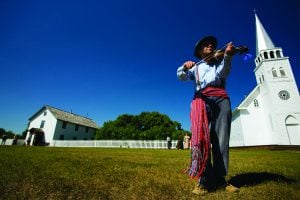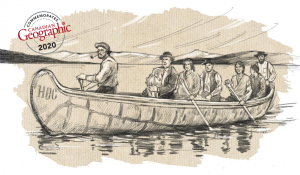
People & Culture
Kahkiihtwaam ee-pee-kiiweehtataahk: Bringing it back home again
The story of how a critically endangered Indigenous language can be saved
- 6310 words
- 26 minutes
People & Culture
At the Aki Kikinomakaywin culture camp, Anishinaabe youth weave worldviews together, connecting with their culture and learning to see themselves in the Western sciences

This article originally appeared at biinaagami.org, a change-provoking initiative seeking to uplift the stories of the Great Lakes-St. Lawrence watershed.
As a misty July rain provided temporary relief from the typically moose-fed bloodsuckers in a woodland clearing, 17 Anishinaabe high schoolers file in through an opening in a circle of people. In a time-honoured tradition of emulating the path of the sun, they instinctively follow an invisible clockwise trail to their chosen seat, where they would take in the teachings and stories of their Elders. Later, as the circle was disbanded, they would continue on the same orbital plane until the circular journey was complete. It’s an Anishinaabe teaching to observe such circle protocol, one the youth know by heart. There is no moving counterclockwise, slipping out of a crack between chairs, or, most egregious of all, cutting through the centre. These learners are participating in an unspoken social contract handed down through generations since time immemorial.
This particular circle was one of many traditional teachings that this group of teens aged 14 to 16 was here to learn at Aki Kikinomakaywin. An Anishinaabe culture camp at Lakehead University, Aki Kikinomakaywin means “learning on the land” in Anishinaabemowin. Organized by a diverse team of Indigenous Elders, young adults, parent volunteers, and community partners, Aki Kikinomakaywin aims to revitalize and teach Anishinaabe culture and promote the practice of “two-eyed seeing” in STEAM (science, technology, engineering, arts and mathematics). Two-eyed seeing is a guiding principle introduced by Mi’kmaw Elder Albert Marshall two decades ago, where learners observe the value of Indigenous ways of knowing through one eye and Western ways of knowing with the other.
Anishinaabe Elder Sheila De Corte, Turtle Clan of Animkii Wajiw, cuts a path through the treeline, where the dense canopy shelters us from the sweet summer rain. In the sudden darkness, mosquitoes descend en masse. Though the small group of students Sheila has is in tow seem impervious. She’s leading a medicine walk at S.O.I.L., the School of Indigenous Learning in Neebing, just south of Thunder Bay, and nothing will break their focus. As she goes, she introduces us to Plantain for stings and bites, Mullein for the respiratory and immune systems, Saskatoon Berry for a sweet trail snack, and Grandfather root to teach all other plants how to work together in a tonic — as if she was introducing old friends.

“Everything we need, we already have. Creator gave it to us. It’s just about building those relationships,” De Corte explains, a worldview demonstrated throughout the camp, as the adults modelled loving interactions with nature.
Water Walker and Bear Clan Elder Sharon Manitowabi of Wikwemkoong showed that love in the way she talked about the waters. Beside the flowing waters of the McIntyre River, she invites others to introduce themselves to the water and offer tobacco, a sacred medicine. “The water loves you,” she reminds the small group of teens. “We begin our lives in water. From the time we are just cells, we live in our mother’s water. We are water.”
Framing nature as part of ourselves in Indigenous cultures emboldens environmentalism from a young age. When we know that water is alive, with a spirit, memory, and an important job to do in sustaining all of Creation, we understand human beings also have responsibilities toward the waters.
“It used to be illegal to do stuff like this,” says Elder De Corte on sharing water songs. “They tried to take all this knowledge away from us, but we Anishinaabe are resilient. Our wise Elders hid these knowledge bundles away until we were allowed to use them again.”
Indeed, “any Indian festival, dance or other ceremony” was made illegal under the Indian Act in 1895 and would remain so until 1951, a time many Elders can remember. “I think about how sad the waters must have been all these decades when we weren’t allowed to do ceremony,” Manitowabi reflects.
The youth seized every chance they could to reawaken the knowledge their ancestors stored away. Young men, including Aiden and Nicholas, took turns fire keeping. They smudged all the people and the sacred items at the open and close each day, filling the lodge with the familiar smoke of white sage. The whole group enthusiastically sang honour songs, embraced ceremonial protocol, created traditional artwork, harvested medicines — and every single one of them proudly spoke as much Anishinaabemowin as they knew.

Aspen Starr of Biigtigong Nishnaabeg clung to every lesson that De Corte and Manitowabi imparted. A dancer herself, Aspen teaches me about the ribbon skirts the youth were gifted as part of the camp. “Ribbon skirts are shaped like teepees because they’re meant to feel like home,” she says. “So, whenever I dance, I feel like I’m home. And that Powwow circle, the people I dance with, they’re all my family. They’re my siblings. And I’m glad I get to be at home.”
This familial sense of belonging was felt so strongly at the camp in a way that isn’t always possible for Indigenous students in the settler-colonial school system. The youth saw their culture reflected in the work of all the adults around them. They saw Anishinaabe as scientists, teachers, photographers, activists, artists, singers, dancers, athletes. And, in every career path, they witnessed Indigenous knowledge and respect for our more-than-human relations guiding the work.
On one of the final days of the camp, the campers don their ribbon skirts and shirts, and introduce themselves to the water, offering tobacco, the way they’ve learned. This time, they wade in equipped with pipettes, clipboards and sample containers as part of a stream assessment led by charity Water First, which works with Indigenous communities to address water challenges.
Sitting on the banks of the stream, they analyzed their samples and discussed bio-cultural stream assessments. Later, they viewed those same samples under a microscope, marvelling at the infinitesimal life water holds, while conducting a benthic macroinvertebrate study to calculate a water quality index. In a perfect example of two-eyed seeing, the camp infused Western scientific ways of learning about water into traditional Anishinaabe ways of learning from water.
“Reconnecting [to culture] and learning these things has changed how I walk through the world,” says Aki Kikinomakaywin project lead Lydia Johnson of the Cree Nation. “I hope for that for them too.”

Are you passionate about Canadian geography?
You can support Canadian Geographic in 3 ways:

People & Culture
The story of how a critically endangered Indigenous language can be saved

Travel
The new movement building flourishing tourism hubs across Canada – one sustainable example at a time

People & Culture
For generations, hunting, and the deep connection to the land it creates, has been a mainstay of Inuit culture. As the coastline changes rapidly—reshaping the marine landscape and jeopardizing the hunt—Inuit youth are charting ways to preserve the hunt, and their identity.

History
A look back at the early years of the 350-year-old institution that once claimed a vast portion of the globe